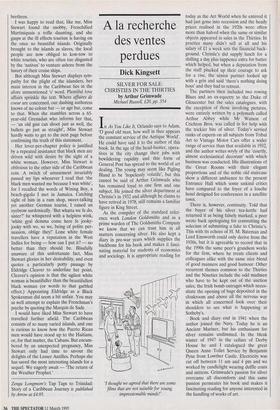A la recherche des ventes perdues
Dick Kingsett
SILVER FOR SALE:
CHRISTIES IN THE THIRTIES by Arthur Grimwade Michael Russell, f20, pp. 354 In As You Like It, Orlando says to Adam, '0 good old man, how well in thee appears the constant service of the Antique World'. He could have said it to the author of this book. In the age of the head-hunter, opera- tives in the city change their jobs with bewildering rapidity and this form of General Post has spread to the world of art dealing. The young may seem like Pigling Bland to be 'hopelessly volatile', but this cannot be said of Arthur Grimwade who has remained loyal to one firm and one subject. He joined the silver department at Christie's in 1932 and although he claims to have retired in 1978, still remains a familiar figure in King Street. As the compiler of the standard refer- ence work London Goldsmiths and as a prime warden of The Goldsmiths Company we know that we can trust him in all matters concerning silver. He also kept a diary in pre-war years which supplies the backbone for his book and makes it fasci- nating material for students of economics and sociology. It is appropriate reading for 'I thought we agreed that there are some films that are not suitable for young, impressionable minds!' today as the Art World when he entered it had just gone into recession and the heady prices realised in the 1920s were often more than halved when the same or similar objects appeared in sales in the Thirties. In practice many didn't sell at all and his salary of E1 a week sets the financial back- ground. Christie's did supply lunch for a shilling a day plus tuppence extra for butter which helped, but when a deputation from the staff plucked up their courage to ask for a rise, the senior partner looked up with a grin and said 'there's nothing doing boys' and they had to retreat.
The partners then included two rowing Blues and an ex-equerry to the Duke of Gloucester but the sates catalogues, with the exception of those involving pictures, were entirely written by a polymath called Arthur Abbey while Mr Watson of Crichton Bros. was called in for help with the trickier bits of silver. Today's serried ranks of experts on all subjects from Tribal Art to Vintage Motor Cars offer a wider range of service than that available in 1932, and the author writes wryly of the 'courtly, almost ecclesiastical decorum' with which business was conducted. His illustrations of the Great Rooms with their elegant proportions and of the noble old staircase show a different ambience to the present Entrance Hall which some unkind critics have compared to the foyer of a louche hotel designed for conferences in a satellite town.
There is, however, continuity. Told that the buyer of his silver tea-kettle had returned it as being falsely marked, a peer wrote back apologising for committing the solecism of submitting a fake to Christie's. This with its echoes of H. M. Bateman and Lord Emsworth could only derive from the 1930s, but it is agreeable to record that in the 1990s the same peer's grandson works for the firm, where he treats clients and colleagues alike with the same nice blend of good manners and good humour. Other recurrent themes common to the Thirties and the Nineties include the odd madmen who have to be kept out of the auction sales, the Irish bomb outrages which neces- sitate the opening of bags deposited in the cloakroom and above all the nervous way in which all concerned look over their shoulders to see what is happening at Sotheby's.
Book and diary end in 1941 when the author joined the Navy. Today he is an Ancient Mariner, but his enthusiasm for silver remains undimmed. In the bleak winter of 1947 in the cellars of Derby House he and I catalogued the great Queen Anne Toilet Service by Benjamin Pyne from Lowther Castle. Electricity was cut off between 11 am and 4 pm and we worked by candlelight wearing duffle coats and mittens. Grimwade's passion for silver overcame all discomforts and this same passion permeates his book and makes it fascinating reading for anyone interested in the handling of works of art.


























































 Previous page
Previous page